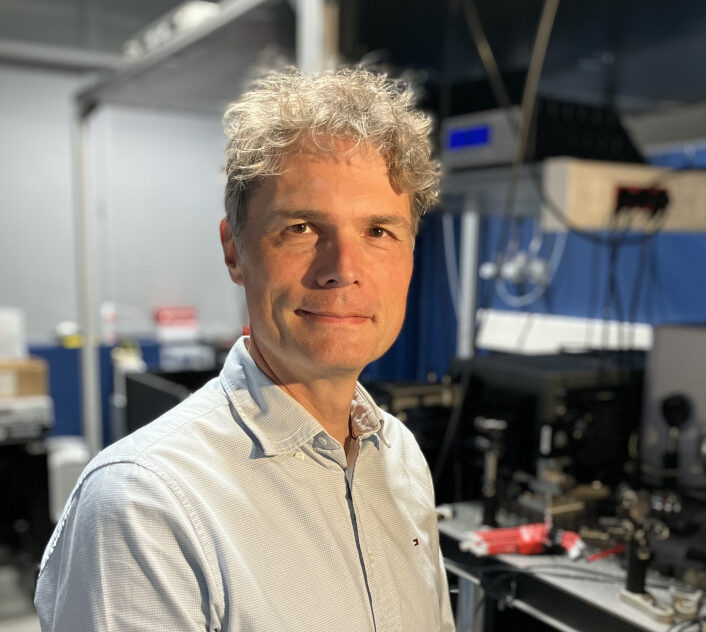Guillaume Cassabois: Quantum matter
Thanks to original results on semiconductor nanostructures and in particular on the physical properties of boron nitride, physicist Guillaume Cassabois of the Charles Coulomb Laboratory laboratory has just been awarded the Grand Prix Jean Ricard 2025 by the French Physics Society. While the award recognizes individual achievement, Cassabois emphasizes the importance of teamwork throughout his research.

Guillaume Cassabois works on the scale of the infinitely small, where quantum laws reign. For those who fear they don't understand his research, the physicist from the Charles Coulomb laboratory and professor at the University of Montpellier is reassuring: " We all live in a quantum world. Lasers, MRI imaging and the transistors that make up computers are all technologies inherited from a century of research into quantum mechanics.
Arsenide or graphene
He studies semiconductor nanostructures using optical spectroscopy. He is thus contributing to the second quantum revolution, which began in the 2010s and seeks to apply quantum properties at the atomic scale to new technologies. Among these technologies, the best-known - and perhaps least successful - project is the quantum computer, which would use matter's ability to be in two states at once to compute much faster.
After defending his thesis at the Ecole Normale Supérieure in 1999, Guillaume Cassabois devoted the early part of his career to the qubit, the quantum bit which, unlike our current computers where transistors manipulate 0s or 1s, can be both 0 and 1. Then a lecturer at Jussieu, he tried to manufacture this qubit by creating a quantum box, an object just a few nanometers in size made of indium arsenide. In the end, superconductors won out over the quantum box in the qubit race. The researcher then turned his attention to nanotubes, a nanostructure made from graphene, a single layer of carbon atoms organized in a honeycomb pattern, which can emit single photons. Among quantum applications, the single photon is a sought-after commodity. As in quantum cryptography, where the impossibility of creating a perfect copy of a photon enables messages to be encoded in an unbreakable way.
Silicon defects
Joining the University of Montpellier in 2010, Guillaume Cassabois is exploring yet another new avenue: optical defects in silicon. " Such a defect exists in diamond, enabling it to emit single photons on demand at visible wavelengths. My intuition was to find the equivalent in silicon, a material widely used in microelectronics and which could emit in the infrared, at the wavelengths of telecom optical fiber. "
Bingo. His team is the first in 2019 to observe the desired defects. Guillaume Cassabois rightly emphasizes the role of the collective in this achievement: " Anaïs Dréau [L2C researcher and 2025 winner of the Prix Gustave Ribaud from theAcadémie des Sciences] was setting up a high-performance experimental device to study silicon carbide, an operation that Vincent Jacques (L2C) was able to support financially with leftover funding from his ERC. " He goes on to argue that collaboration and " small nest eggs " in the laboratories are decisive for staying in the race against the heavyweights from the USA and China. Today, the Montpellier team is contributing to pioneering international advances in the technological application of this discovery, which enables quantum emitters to be integrated into silicon chips.
Boron nitride on board
Taking advantage of another of his laboratory's assets, ultraviolet optical spectroscopy, mastered locally by Bernard Gil, Guillaume Cassabois is now tackling the properties of another semiconductor material, boron nitride (BN). " Initially, when I was working on massive crystals just a few millimetres in size, I had the impression that I was doing physics from the 1960s. I had no idea of the incredible physical properties of this material, which has a structure similar to graphene ". With his colleague Pierre Valvin, they achieved an experimental feat " using two-photon spectroscopy in the deep ultraviolet " and revealed the exceptional optical properties of this material, which could enable the manufacture of LEDs in the deep ultraviolet for water sterilization and surface disinfection.
" This seminal work marked the birth of a new field, which is now booming: boron nitride photonics ", pointed out an article by the Société française de physique, on the occasion of the Grand Prix Jean Ricard 2025, a prize awarded to a physicist for outstanding and original work. Guillaume Cassabois launched the first international workshop on boron nitride in Montpellier in 2023, a conference which has since been held in Australia, the United States and soon Korea...
